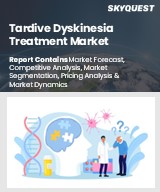
Report ID: SQMIG35I2373
Skyquest Technology's expert advisors have carried out comprehensive research on the tardive dyskinesia treatment market to identify the major global and regional market trends and growth opportunities for leading players and new entrants in this market. The analysis is based on in-depth primary and secondary research to understand the major market drivers and restraints shaping the future development and growth of the industry.
Regulatory Support and Accelerated Approvals
Growing Awareness and Educational Initiatives
Adverse Effects of Current Therapies
Limited Awareness in Low-Income Regions
REQUEST FOR SAMPLE
Global Tardive Dyskinesia Treatment Market size was valued at USD 9.75 Billion in 2023 and is poised to grow from USD 10.11 Billion in 2024 to USD 13.52 Billion by 2032, growing at a CAGR of 3.7% during the forecast period (2025-2032).
Tardive dyskinesia treatment providers should focus on investing in R&D to develop new therapeutics and treatments. Working with government organizations and health non-profits can also expand the business scope for market players. Developing treatment with minimal side effects is a key opportunity as per the global tardive dyskinesia treatment market analysis. 'Teva Pharmaceutical Industries Ltd.', 'Neurocrine Biosciences Inc.', 'Medicure Inc.', 'Mylan N.V', 'Dr. Reddy’s Laboratories Ltd.', 'Sun Pharmaceutical Industries Ltd. ', 'Bionpharma', 'Hetero', 'Bausch Health', 'Sanofi', 'Johnson & Johnson Services Inc.', 'GlaxoSmithKline Plc.', 'Lupin Pharmaceuticals Inc.', 'Lilly', 'Novartis AG'
Regulatory agencies, notably the U.S. Food and Drug Administration (FDA), have adopted expedited pathways for TD treatments, recognizing the unmet medical need. Fast-track designations and priority reviews facilitate quicker market entry for promising therapies. This regulatory support incentivizes pharmaceutical companies to invest in TD drug development and favors the global tardive dyskinesia treatment market outlook as well.
Advancements in VMAT2 Inhibitor Therapies: The development and approval of vesicular monoamine transporter 2 (VMAT2) inhibitors, such as valbenazine (Ingrezza) and deutetrabenazine (Austedo), have revolutionized TD treatment. These medications specifically target the underlying mechanisms of TD, offering improved efficacy and safety profiles compared to traditional therapies. The introduction of alternative formulations, like Ingrezza Sprinkle, caters to patients with swallowing difficulties, enhancing treatment adherence. Hence, focusing on advancement of therapies is slated to be a top tardive dyskinesia treatment market trend in the long run.
Why is the Adoption Rate of Tardive Dyskinesia Treatment High in North America?
Want to customize this report? This report can be personalized according to your needs. Our analysts and industry experts will work directly with you to understand your requirements and provide you with customized data in a short amount of time. We offer $1000 worth of FREE customization at the time of purchase.
Feedback From Our Clients

Report ID: SQMIG35I2373
sales@skyquestt.com
USA +1 351-333-4748